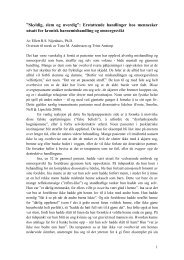rapport 2015:4
641aa6d88d
641aa6d88d
You also want an ePaper? Increase the reach of your titles
YUMPU automatically turns print PDFs into web optimized ePapers that Google loves.
107. Warren, A.R., et al. (1999). Assessing the effectiveness<br />
of a training program for interviewing child<br />
witnesses. Applied Developmental Science. 3(2):<br />
p. 128-135.<br />
108. Alldred, P. (1998). Ethnography and discourse<br />
analysis: Dilemmas in representing the voices<br />
of children, in Feminist dilemmas in qualitative<br />
research: Public knowledge and private lives, Sage<br />
Publications, Inc; US: Thousand Oaks, CA. p.<br />
147-170.<br />
109. Driessnack, M. (2006). Draw-and-tell conversations<br />
with children about fear. Qualitative Health<br />
Research. 16(10): p. 1414-1435.<br />
110. Harcourt, D. (2011). An encounter with children:<br />
Seeking meaning and understanding about<br />
childhood. European Early Childhood Education<br />
Research Journal. 19(3): p. 331-343.<br />
111. Prout, A. (2001). Representing children: reflections<br />
on the children 5–16 programme. Children &<br />
Society. 15(3): p. 193-201.<br />
112. Clavering, E. and J. McLaughlin (2010). Children’s<br />
participation in health research: from objects to<br />
agents? Child: Care, Health and Development.<br />
36(5): p. 603-611.<br />
113. Danby, S., L. Ewing, and K. Thorpe (2011). The<br />
novice researcher: Interviewing young children.<br />
Qualitative Inquiry. 17(1): p. 74-84.<br />
114. Kjørholt, A.T. (2004). Childhood as a social and<br />
symbolic space: discourses on children as social<br />
participants in society. Thesis, Department of<br />
Education / Norwegian Centre for Child Research<br />
Faculty of Social Sciences and Technology Management.<br />
Norwegian University of Science and<br />
Technology, NTNU: Trondheim.<br />
115. Aronsson, K. and K. Hundeide (2002). Relational<br />
rationality and children’s interview responses.<br />
Human Development. 45(3): p. 174-186.<br />
116. Andenæs, A. (1991). Fra undersøkelsesobjekt til<br />
medforsker? Livsformsintervju med 4-5 åringer.<br />
Nordisk Psykologi. 43(4): p. 274-292.<br />
117. Haglund, K. (2004). Conducting life history<br />
research with adolescents. Qualitative Health<br />
Research. 14(9): p. 1309-1319.<br />
118. Komulainen, S. (2007). The ambiguity of the child’s<br />
‘voice’ in social research. Childhood-a Global<br />
Journal of Child Research. 14(1): p. 11-28.<br />
119. Kirova, A. (2006). A game-playing approach to<br />
interviewing children about loneliness: Negotiating<br />
meaning, distributing power, and establishing trust.<br />
Alberta Journal of Educational Research. 52(3): p.<br />
127-147.<br />
120. Epstein, I., et al. (2008). Using puppetry to elicit<br />
children’s talk for research: Feature. Nursing<br />
Inquiry. 15(1): p. 49-56.<br />
121. Holmsen, M. (1999). Samtalebilder og barnetegninger<br />
som del av en intervju-metode. Spesialpedagogikk<br />
(Årg. 64, nr 3): p. 14-20 : ill.<br />
122. Stjerna, M.L. and A. Marttila (1999). How to get a<br />
comprehensive material in focus group interviews?<br />
- Experiences from a study with young people.<br />
Socialmedicinsk Tidskrift. 76(4): p. 332-9.<br />
123. Johnsen, A. and V.W. Torsteinsson (2012). Lærebok<br />
i familieterapi. Oslo: Universitetsforlaget.<br />
124. Carr, A. (2014). The evidence base for family<br />
therapy and systemic interventions for childfocused<br />
problems. Journal of Family Therapy. 36:<br />
p. 107-157.<br />
125. Pote, H., Stratton, P. , Cottrell, D., Boston, P. ,<br />
Shapiro, D. , Hanks, H. Systemic Family Therapy<br />
Manual. Leeds Family Therapy & Research Centre,<br />
University of Leeds. Tilgjengelig fra: http://<br />
medhealth.leeds.ac.uk/info/645/academic_unit_<br />
of_psychiatry_and_behavioural_sciences/1365/<br />
leeds_family_therapy_and_research_centre.<br />
126. Carr, A. (2009). The effectiveness of family therapy<br />
and systemic interventions for child-focused problems.<br />
Journal of Family Therapy. 31: p. 3-45.<br />
127. Willott, S., Hatton, T., Oyebode, J. (2012). Reflecting<br />
team processes in family therapy: A search for<br />
research. Journal of Family Therapy. 32: p. 1-24.<br />
128. Torsteinsson, V.W. (2007). Den kliniske artikkelen<br />
- noe mer enn anekdoter fra terapirommet? Fokus<br />
på familien(Årg. 35, nr. 2): p. [88]-101.<br />
129. Carr, A. (2000). Evidence-based practice in family<br />
therapy and systemic consultation: I: Child-focused<br />
problems. Journal of Family Therapy. 22(1): p.<br />
29-60.<br />
Rapport <strong>2015</strong>:4 • Folkehelseinstituttet 97



